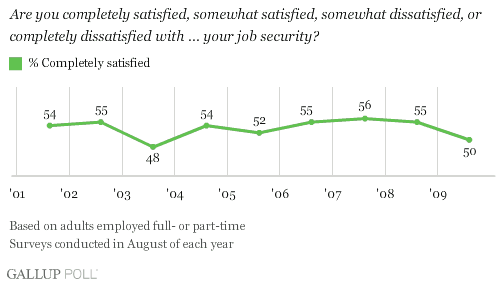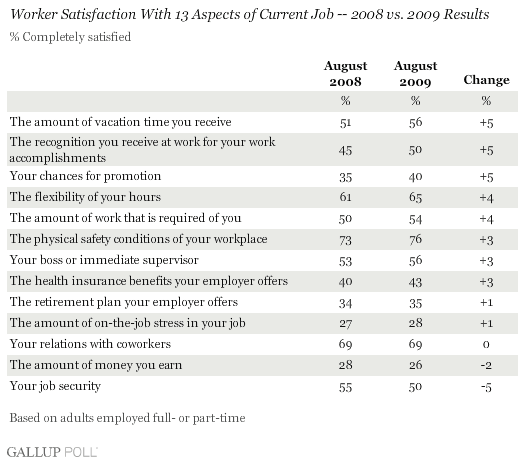PRINCETON, NJ -- The disquieting nature of today's job market -- rocked by the highest unemployment rates in over two decades -- is reflected in workers' reduced satisfaction with their own job security. While 50% of Americans employed full- or part-time are completely satisfied with their job security today, this is the lowest level seen since 2003, and is down from a high of 56% in 2007.

Altogether, 80% of U.S. workers are either completely or somewhat satisfied with their job security, but most of the variation over time in this and other Gallup Poll job satisfaction ratings is seen in the percentage "completely satisfied."
This year's Gallup Poll Social Series Work and Education poll was conducted Aug. 6-9, at a time when Gallup Daily tracking showed as many American workers reporting that their workplaces were letting people go as said they were hiring (25% each for the week of Aug. 3-9). That stands in sharp contrast to the same week in 2008, when, by 2 to 1 (35% vs. 17%), more workers perceived that the sizes of the workforces at their places of employment were expanding.
At the same time, workers' satisfaction with nearly all other facets of their workplace experience has improved slightly or stayed the same since August 2008. The only area, in addition to job security, in which satisfaction declined (although not by a statistically significant amount) is pay.

As a result of these shifts, some of which are quite small, workers are now registering the highest satisfaction levels Gallup has seen with respect to their vacation time (56% completely satisfied), health insurance benefits (43%), workload (54%), opportunities for promotion (40%), safety conditions (76%), and personal recognition (50%).
This year's survey marks only the second time that at least 40% of workers have been completely satisfied with the health insurance benefits offered by their employers. This is particularly noteworthy given the national healthcare reform debate, with some critics saying the public option could force workers out of their employers' plans and into the government's.

Nevertheless, the overall ranking of workplace conditions according to employee satisfaction is very similar to last year's. The highest satisfaction levels, with 60% or more "completely satisfied," are seen for physical safety conditions, relations with coworkers, and flexibility of work hours. The lowest satisfaction, with fewer than 40% satisfied in 2009, is seen for pay, on-the-job stress, and employers' retirement plans. The biggest year-to-year change is the drop in placement of job security from 4th of 13 areas rated in 2008 to 7th place today.
Even with this year's slight increase in satisfaction, healthcare still ranks in the lower half of the job attributes. However, solid majorities of Americans are at least somewhat satisfied with their employers' healthcare benefits, as well as with all of the workplace dimensions rated.

Bottom Line
Amid all the economic uncertainty swirling around American workers today, Gallup finds an understandable softening of workers' sense of job security. At the same time, with satisfaction scores at or near record highs for many aspects of employment, workers are showing, perhaps, a bit greater appreciation for their jobs than in years past.
The implications of this could go well beyond workers' personal mood. Continued strong coworker and boss-worker relations in 2009 -- combined with expanded satisfaction around personal recognition, workload, and flex time -- stand out as potentially beneficial to the U.S. economy at a time when greater worker innovation and productivity may be important catalysts for growth.
Survey Methods
Results are based on telephone interviews with 1,010 national adults, aged 18 and older, conducted Aug. 6-9, 2009. For results based on the total sample of national adults, one can say with 95% confidence that the maximum margin of sampling error is ±4 percentage points.
Interviews are conducted with respondents on land-line telephones (for respondents with a land-line telephone) and cellular phones (for respondents who are cell-phone only).
In addition to sampling error, question wording and practical difficulties in conducting surveys can introduce error or bias into the findings of public opinion polls.
